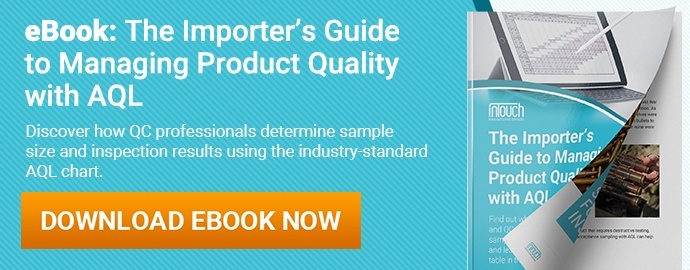 Have you ever received a QC inspection report for your product and made a decision to ship or hold an order that was contrary to the main result shown in the report?
Have you ever received a QC inspection report for your product and made a decision to ship or hold an order that was contrary to the main result shown in the report?
For most importers that have hired QC staff to conduct pre-shipment inspection of their product, the answer is “yes”. This is especially true for importers manufacturing in China, and throughout Southeast Asia, where a great deal of manufacturing takes place. You might choose to approve shipping for a failing order or request product rework for a passing order for any number of reasons.
A reliable inspection report does provide detailed information and insight into the quality, status and condition of your goods. But the inspection result itself doesn’t dictate to you whether or not you should accept the order. And if inspection criteria and scope aren’t adequately defined prior to inspection, the inspection result often won’t accurately reflect your standards.
Let’s jump into how QC inspectors reach a result, how to interpret results and how you can use them to your advantage when deciding to accept or reject an order.
What information is used to arrive at a QC inspection result
An inspection report is the result of an inspector’s on-site examination of your order and is meant to give you a snapshot of its status. QC staff use a number of reference materials provided by importers to check products according to agreed-upon standards. These typically include the purchase order (PO), any CAD drawings, QC checklists and other documents. You may also need your product to pass certain on-site tests related to function, performance or safety. Inspectors document any deviations from these requirements in their report.
Another major factor of inspection results is what’s called an acceptable quality limits (AQL) result (related: The Importer's Guide to Managing Product Quality with AQL [eBook]). QC staff often apply an AQL standard during inspection to determine the quality of an entire lot based on findings they obtain from a random sample of units. When determining which AQLs are best for your order, it’s imperative to choose those that balance cost with insight into order quality.
Clear expectations help you ensure inspection results are accurate
All reference materials and inspection criteria need to be accurate and readily available to you, your QC team and your supplier. This is true no matter whether you’ve hired a third-party inspector, full-time inspector or are sending someone from your company to inspect.  And even if you’re relying on QC staff at the factory to inspect, providing all your requirements ahead of time will help ensure they understand your expectations.
And even if you’re relying on QC staff at the factory to inspect, providing all your requirements ahead of time will help ensure they understand your expectations.
Ideally, you’ll specify criteria for inspection well before the inspector actually arrives at the factory—even before the factory begins mass production. By working with your supplier and QC staff to develop inspection criteria, everyone involved will know by what standards the finished goods will be judged. Many experienced importers create a QC checklist to better convey these expectations in a concise and easy-to-follow document.
How to interpret your product inspection results
Most product inspections yield one of three overall results:
- “Pass” – product quality is within pre-determined AQLs, the product has passed any on-site tests required and it meets any other requirements or regulations
- “Fail” – the quantity of defects or nonconformities in excess of AQLs, the product has failed one or more important on-site test or it has not met a critical requirement or regulation
- “Pending” - quality is within pre-determined AQLs, the product has passed any on-site tests required and it meets any other requirements or regulations, but there’s some issue the inspector wants to bring to the importer’s attention that was not included in reference documents or specifications
Inspectors may use different language in reporting results, such as “accept” instead of “pass”, or “hold” instead of “fail”, or use specific AQL terminology. But generally, these are the characteristics which define these basic results.
Most of the time, especially when repeated inspections have solidified criteria, you can make a simple decision based on a result of pass or fail. But there are some exceptions when you might accept or reject an order, despite an inspection result that seems to indicate otherwise.
When you might reject a passing QC inspection result
QC professionals typically strive to properly apply your standards to the product during inspection. And a passing result should indicate that an order can be shipped. But there are cases where you might reject a shipment, despite a passing result. This decision often shows that you omitted a vital piece of information from the criteria used during that inspection.
 For example, let’s say you place an order for 5,000 felt pens from a supplier in Shanghai. But you’ve neglected to specify the ink color in your inspection criteria. Your inspector may check a sample of 200 pens and find them properly packaged and conforming to criteria for visual and functional inspection. According to the provided criteria, this is a “pass” result. But when you review the report, you notice that the pens have blue ink, although you actually required black ink.
For example, let’s say you place an order for 5,000 felt pens from a supplier in Shanghai. But you’ve neglected to specify the ink color in your inspection criteria. Your inspector may check a sample of 200 pens and find them properly packaged and conforming to criteria for visual and functional inspection. According to the provided criteria, this is a “pass” result. But when you review the report, you notice that the pens have blue ink, although you actually required black ink.
The chance of this happening is typically quite small because you would’ve likely outlined such an obvious point to your QC provider in China. Yet this example demonstrates how omitting any requirements can lead to distorted inspection results—not to mention frustrating factory management and workers that must rework or replace goods, despite having passed inspection.
When you might accept a failing product inspection result
As an importer, you may decide to accept an order that’s failed inspection. Just as rejecting an order that’s passed inspection, this most often reflects inaccurate or incomplete criteria used for inspection. You might also accept an order that’s failed due to defects or nonconformities that you don’t consider serious, often reported as “minor” AQL defects (related: 3 Types of Quality Defects in Different Products). And you might accept an order that fails inspection if you urgently need to ship the goods. But you can almost always prevent this by arranging inspection well ahead of the expected ship date.
How to handle a pending inspection result
Pending inspection results arise from an inspector erring on the side of caution when they’ve found one or more potential issues that inspection criteria don’t clearly address. A factory representative may have refused to allow inspectors to conduct a particular on-site test. Or inspectors may have measured product dimensions and found them nonconforming in the absence of any tolerances. These are examples in which the inspector may require feedback from the importer before determining a clear pass or fail result.
 If you decide the issues in a pending report aren’t serious enough to reject the order, you might approve the order for shipping. Similarly, you may reject the order if the issues found in the report require re-inspection or action from the factory.
If you decide the issues in a pending report aren’t serious enough to reject the order, you might approve the order for shipping. Similarly, you may reject the order if the issues found in the report require re-inspection or action from the factory.
Any time you have a pending inspection result, or your shipping decision runs contrary to the result, give feedback to your inspection team on how to consider these issues in future inspections so as to avoid a similar situation in the future. And if requirements change between arranging QC inspection and receiving the results, update your supplier and inspector immediately to prevent confusion.
How to use product inspection reports to your benefit
With the possibility of ambiguity you can find in some inspection reports, what value does inspection really offer? The main value of seeing an inspection report is that it gives you the transparency you need to accept or reject an order. And the factory manufacturing your product will often benefit if inspectors find issues that the factory’s own QC staff might have overlooked.
Inspection reports empower importers to make an informed shipping decision
It should be clear now that it’s important to review an inspection report in full, rather than relying only on the overall result typically shown on the first page. All the information in the report helps you understand what’s really going on with your product at the factory. And this information is helpful in avoiding shipping an order that doesn’t meet expectations, a problem often resulting in unsellable product or costly rework needed after the goods have already left the factory.
QC inspectors typically don’t have the authority to control goods after inspection. Their duty is to act as your eyes and ears in the factory. As the importer, only you can instruct your supplier on any follow-up action, since QC inspectors rarely work with factory staff to fix issues. Only you can make decisions with the supplier related to the scope of rework, what will be fixed, how many units need to be replaced and other remedies needed before shipping.
Inspection reports help factories too
Although it might seem like inspection is meant to incriminate your supplier mistakes made in production, this isn’t the case. Some suppliers may resist inspection because they’re trying to hide something. But outside inspection can actually benefit suppliers by helping factories improve.  When there are quality issues in an order, inspection reports can highlight shortcomings in the factory’s production and internal QC processes. Once corrected, these improvements help suppliers serve their customers better.
When there are quality issues in an order, inspection reports can highlight shortcomings in the factory’s production and internal QC processes. Once corrected, these improvements help suppliers serve their customers better.
For example, one importer had been ordering a plastic item from China for years, but inspection revealed an imperfection on 100 percent of an order which was absent in previous orders. The factory’s internal QC staff missed this issue. Factory staff soon found that the issue was caused by improper maintenance of the mold used in the injection process. The factory was able to clean the mold properly so that the defect would not affect future orders.
Conclusion
Inspection reports offer a comprehensive quality snapshot to importers, especially when essential, agreed-upon inspection criteria are provided beforehand (related: How AQL Sampling Affects Your Product Inspection Results). They provide the details necessary for educated decision making. But a “fail” or “pass” result alone isn’t always an immediate guarantee that an order should ship.
When it comes down to the decision of shipping an order, your QC inspection results can eliminate a lot of the guesswork. But, ultimately, it’s your responsibility to analyze the results and liaise with your supplier about necessary next steps. Keeping this in mind will help you get the most out of QC inspection for your products.
Do you have questions about how to interpret your inspection reports? Let us know in the comments section below!







